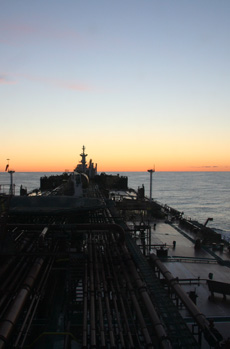|
Health & safety
- No emissions from the cargo during transport reduces the risk of a fire or explosion onboard, since no hydrocarbons will be released to the atmosphere surrounding the tanker.
- This also minimizes the crew's exposure to hydrocarbons. Long-term exposure can cause damage to the liver, kidneys and central nervous system. Short-term exposure can cause eye and respiratory tract irritation, headaches, dizziness, visual disorders, fatigue, loss of coordination, allergic skin reactions, nausea, and memory impairment. A number of hydrocarbons are also considered toxic, meaning they may cause cancer or other serious health problems [link to source].
- Since the CVOC™ system will have a direct effect on the amount of vapors emitted through the cargo venting system, it will also limit emissions of Hydrogen Sulphide (H2S) during loading, and eliminate emissions during transport.
- Automatic pressure reduction in the cargo tanks eliminates the need of sending crew members out on deck to open the mast riser manually during rough weather.
Environment
- VOC contains several gases contributing to the greenhouse effect, including Methane (CH4), which has a global warming potential (GWP) of 20 compared to Carbon Dioxide (CO2), meaning that Methane is more than 20 times more effective in trapping heat in the atmosphere than Carbon Dioxide(CO2) [link to source].
- Other components in VOC contributes to the formation of ground-level Ozone (O3). Breathing ozone can trigger a variety of health problems including chest pain, coughing, throat irritation, and congestion. It can worsen bronchitis, emphysema, and asthma. Ozone also can reduce lung function and inflame the linings of the lungs. Repeated exposure may permanently scar lung tissue. It also damages crops, trees and other vegetation. It is a main ingredient of urban smog [link to source].
- Using the CVOC system to control the tank pressure will reduce the risk of PV valves opening in rough weather, thus potentially avoiding oil spill through the PV valves caused by rough sea.
Economy
Measuring actual cargo loss during loading and transport has proven to be a difficult task. Several different approaches have been tried with varying results. The following are just examples:
- GBA Marine and Teekay Shipping did a series of measurements on the Teekay world fleet in 2004 to establish figures for VOC loss during transport. This concluded with average emissions of 2-5 tonnes per day based on measurements from more than 280 voyages.
- INTERTANKO conducted an extensive research program to investigate the behavior of crude oil during transport. About 2,024 crude oil and VOC samples were taken during a total of 361 voyages. On the basis of CRUCOGSA study and further theoretical analysis, INTERTANKO estimates that total VOC emissions is approximately 0.20 percent of the crude oil movements, roughly half of these emissions occurring during transport and half during the loading process [link to source].
- Most major oil companies participate in the Energy Institute Hydrocarbon Management Committee, the HMC-4A. Data submitted from these companies are used to estimate an average net loss, and was for 2010 estimated to be 0,161% of the total shipped volume. The estimated loss during transport (ship loss) was 0,02% [link to source].
Applied on a VLCC of 300,000 DWT and using a typical 30 day voyage the listed alternatives provides the following figures for in-transit losses on one voyage (based on an oil price of USD 100/barrel and a specific gravity of 0,8 kg/liter):
- GBA Marine & Teekay Shipping: 60-150 tonnes (~USD 47,100 - 117,900)
- INTERTANKO: 300 tonnes (~USD 235,800)
- HMC-4A: 60 tonnes (~USD 47,100)
Since the CVOC™ system eliminates emissions during transport, the savings will be 100%. |

